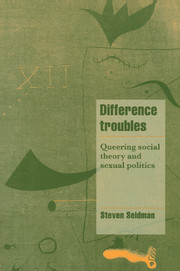Book contents
- Frontmatter
- Contents
- Preface
- Acknowledgements
- Introduction: the contemporary reconfiguring of social theory
- Part I Resisting difference: the malaise of the human sciences
- Part II Engaging difference: from lesbian and gay studies to queer theory
- Part III Democratic prospects: the politics of knowledge and identity
- 8 Transfiguring sexual identity: AIDS and the cultural politcs of sexuality and homosexuality, 1981–1986
- 9 From gay ethnicity to queer politics: the renewal of gay radicalism in the United States
- 10 Postmodern anxiety: the politics of epistemology
- 11 The politics of sexual difference in late twentieth-century America
- 12 Difference and democracy: group recognition and the political cultures of the US, Holland, and France
- Epilogue: pragmatism, difference and a culture of strong democracy
- Notes
- References
- Index
8 - Transfiguring sexual identity: AIDS and the cultural politcs of sexuality and homosexuality, 1981–1986
from Part III - Democratic prospects: the politics of knowledge and identity
Published online by Cambridge University Press: 05 October 2010
- Frontmatter
- Contents
- Preface
- Acknowledgements
- Introduction: the contemporary reconfiguring of social theory
- Part I Resisting difference: the malaise of the human sciences
- Part II Engaging difference: from lesbian and gay studies to queer theory
- Part III Democratic prospects: the politics of knowledge and identity
- 8 Transfiguring sexual identity: AIDS and the cultural politcs of sexuality and homosexuality, 1981–1986
- 9 From gay ethnicity to queer politics: the renewal of gay radicalism in the United States
- 10 Postmodern anxiety: the politics of epistemology
- 11 The politics of sexual difference in late twentieth-century America
- 12 Difference and democracy: group recognition and the political cultures of the US, Holland, and France
- Epilogue: pragmatism, difference and a culture of strong democracy
- Notes
- References
- Index
Summary
AIDS appeared during a period of significant change in American sexual conventions. A series of movements in the 1960s and 1970s pointed in the direction of expanded sexual choice and diversity. The women's movement struggled for women's sexual autonomy. Feminists demanded that women be able to define and control their own sexuality, and that included choosing a lesbian alternative. Less visible were the struggles by sexually disenfranchised groups such as the disabled or the elderly to be accepted as full sexual beings. The counterculture made a more open and expressive eroticism a prominent part of its social rebellion. Furthermore, changes in US sexual norms that reflected long-term trends became more palpable. For example, the norm that legitimated sex only as an act of love or a sign of fidelity was challenged. Sex discourses and representations (e.g., pornography, sex manuals, sex radical ideologies) appeared that constructed sex as a sphere of pleasure and self-expression with its own intrinsic value and justification (Seidman 1991). Some of these discourses defended a libertarian ethic which permitted sex in virtually any context of mutual consent and respect. This expanded the types of relationships in which sex was acceptable. Indeed, the exclusivity of marriage as the proper site for sex gave way to more pluralistic conventions that permitted sex in varied social settings. In short, while it would be misleading to assert that a revolution occurred, there did transpire important changes in US sexual norms and behavior during this period (D'Emilio and Freedman 1988; Seidman 1991a, 1992).
- Type
- Chapter
- Information
- Difference TroublesQueering Social Theory and Sexual Politics, pp. 165 - 184Publisher: Cambridge University PressPrint publication year: 1997

